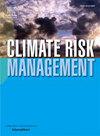气候信息在交通规划中的应用:城市规划组织的调查
IF 5
2区 环境科学与生态学
Q1 ENVIRONMENTAL SCIENCES
引用次数: 0
摘要
气候变化及其对交通系统的潜在影响给可持续发展和社会福祉带来了紧迫的挑战,强调有必要制定计划,减少交通基础设施对海平面上升、极端天气事件和侵蚀加剧等影响的脆弱性。以前的研究侧重于文件分析和案例研究,并强调了在了解交通专业人员如何使用气候科学方面包括交通专业人员需求的重要性。通过直接纳入交通专业的观点,本文旨在填补在交通规划中使用气候信息的理解空白。为了获得有关地方和区域一级交通基础设施规划的数据以及增加资金对气候信息需求的重要性,我们对来自美国都市规划组织(mpo)的区域交通从业者(n = 105)进行了在线调查。该调查调查了这些区域规划者在交通基础设施规划中使用了哪些类型的气候相关信息,这些信息是如何使用的,以及从业人员认为哪些类型的决策支持是最有用的。我们还探讨了两党基础设施法/基础设施投资和就业法案(BIL/IIJA)的实施以及其他因素如何影响对气候信息的需求和使用。我们发现信息提供者需要改进决策支持工具,使它们(a)易于使用和解释,(b)包括明确的方法来建模选项之间的权衡,以及(c)允许用户轻松识别替代方案和决策的影响。我们的数据表明,增加气候信息使用的最明显方法之一是提供继续教育机会,使交通专业人员能够理解和使用气候信息和工具来实现恢复力目标。根据反馈,我们还看到了改善网络的机会,将具有气候服务经验的交通专业人员与经验较少的人员联系起来。本文章由计算机程序翻译,如有差异,请以英文原文为准。
Climate information use in transportation planning: a survey of Metropolitan Planning Organizations
Climate change and its potential to impact transportation systems poses urgent challenges for sustainability and societal well-being, emphasizing a need to plan to reduce transportation infrastructure’s vulnerability to impacts such as sea level rise, extreme weather events, and increased erosion. Previous research has focused on document analysis and case studies and has highlighted the importance of including transportation professional needs in regard to understanding how transportation professionals use climate science. Through direct inclusion of transportation professional perspectives, this paper aims to fill the gaps in understanding about the use of climate information in transportation planning. To obtain data about local and regional level transportation infrastructure planning and the importance of increased funding on the demand for climate information, we conducted an online survey of regional transportation practitioners (n = 105) from United States Metropolitan Planning Organizations (MPOs). The survey examined what types of climate-related information these regional planners are using in the context of transportation infrastructure planning, how it is used, and what types of decision support practitioners think would be most useful. We also explore how the implementation of the Bipartisan Infrastructure Law / Infrastructure Investment and Jobs Act (BIL/IIJA), alongside other factors, may impact the demand for and use of climate information. We find that information providers need to improve decision support tools so they are (a) easy to use and interpret, (b) include explicit methods for modeling tradeoffs among options, and (c) allow the user to easily identify the impacts of alternative scenarios and decisions. Our data suggest that one of the most obvious ways to increase the use of climate information is to provide continuing education opportunities that empower transportation professionals to understand and use climate information and tools toward resilience goals. Based on responses, we also see opportunities for improved networking to connect transportation professionals with prior climate services experience to those who have less experience.
求助全文
通过发布文献求助,成功后即可免费获取论文全文。
去求助
来源期刊

Climate Risk Management
Earth and Planetary Sciences-Atmospheric Science
CiteScore
8.20
自引率
4.50%
发文量
76
审稿时长
30 weeks
期刊介绍:
Climate Risk Management publishes original scientific contributions, state-of-the-art reviews and reports of practical experience on the use of knowledge and information regarding the consequences of climate variability and climate change in decision and policy making on climate change responses from the near- to long-term.
The concept of climate risk management refers to activities and methods that are used by individuals, organizations, and institutions to facilitate climate-resilient decision-making. Its objective is to promote sustainable development by maximizing the beneficial impacts of climate change responses and minimizing negative impacts across the full spectrum of geographies and sectors that are potentially affected by the changing climate.
 求助内容:
求助内容: 应助结果提醒方式:
应助结果提醒方式:


